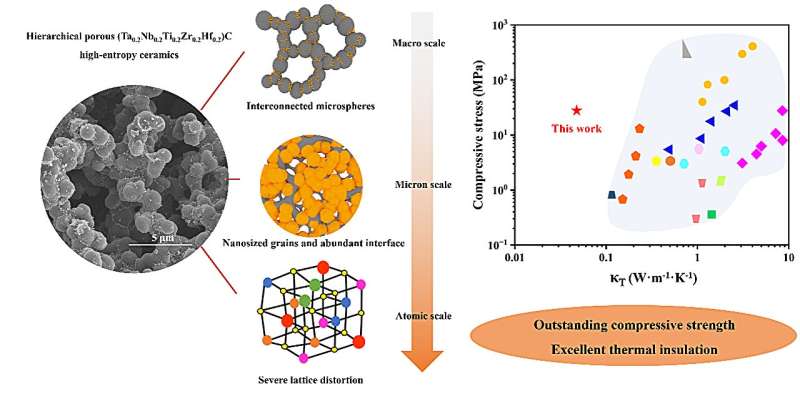This article has been reviewed according to Science X's editorial process and policies. Editors have highlighted the following attributes while ensuring the content's credibility:
fact-checked
proofread
A novel thermal insulation material for ultra-high temperature applications: Hierarchical porous high-entropy ceramics

Thermal insulation material is a critical part of the thermal protection system (TPS) of hypersonic vehicles. Recently, high-entropy ceramics have attracted great attention in thermal insulation for their low thermal conductivity due to the scattering of phonons by multi-components and distorted lattices. Among the various options available, porous high-entropy carbide (PHEC) ceramics have emerged as promising candidates for TPS due to their inherent characteristics such as high melting point, excellent high-temperature stability, low density, and superior thermal insulation properties.
Generally, porous high-entropy carbide ceramics have been fabricated using various methods such as template, direct foaming, and partial sintering. To synthesize these ceramics, metal carbides or oxides are commonly used as starting materials by solid-state methods. This requires extensive milling to disperse the various components and extremely high processing temperatures to accelerate the diffusion of atoms.
However, this approach is energy-intensive and introduces impurities during the ball milling process, which destroys the stoichiometry and affects configurational entropy. Additionally, high-temperature sintering results in grain growth and the elimination of nanosized pores, making it difficult to regulate the porosity and pore structure of the PHEC ceramic. Moreover, the molding and processing of high-entropy carbides is limited by this solid-state method.
Recently, a team of material scientists led by Haibo Ouyang from Shaanxi University of Science and Technology, China reported the fabrication, microstructure, compressive strength and thermal conductivity of the porous (Ta0.2Nb0.2Ti0.2Zr0.2Hf0.2)C high-entropy ceramics by a self-foaming method.
This work not only explains the formation mechanism of the unique hierarchical porosity structure and superior compressive and thermal insulation properties of the porous (Ta0.2Nb0.2Ti0.2Zr0.2Hf0.2)C high-entropy ceramics, but also provides a cost-effective and facility strategy to produce porous ultrahigh temperature ceramics.
The team published their work in the Journal of Advanced Ceramics.
"In this report, we synthesized the porous (Ta0.2Nb0.2Ti0.2Zr0.2Hf0.2)C high-entropy ceramics by a self-foaming method using commercially available metal chloride and furfuryl alcohol as the precursor. This method was inspired by the self-foaming behavior of FA.
"The polymer foam that contains elements like Ti, Zr, Ta, Nb, and Hf can be produced by the self-condensation of FA using metal chlorides as catalysts. The polymer foam transformed into porous ceramics through pyrolysis and carbothermal reduction processes," said Haibo Ouyang, professor at School of Materials Science and Engineering at Shaanxi University of Science and Technology.
"The PHEC ceramic is constructed by microspheres with a size of 2 µm, leading to a high porosity of 91.3% and an interconnected frame. These microspheres consist of high-entropy carbide grains (20 nm), resulting in abundant interface and nanosized pores in the PHEC ceramic," said Ouyang.
"Due to its unique hierarchical structure, the prepared PHEC ceramic has outstanding compressive strength (28.1±2 MPa) and exceptionally low thermal conductivity at room temperature (0.046 W·m−1·K−1). This makes it a promising thermal insulation material in ultrahigh temperature application," said Ouyang.
However, further research is still needed to explore the oxidation resistance of the porous (Ta0.2Nb0.2Ti0.2Zr0.2Hf0.2)C high-entropy ceramics as a new thermal insulation material.
Other contributors include Cuiyan Li, Ruinan Gao, Tianzhan Shen, Zihao Chen, Yanlei Li from the School of Materials Science and Engineering at Shaanxi University of Science and Technology, China.
More information: Cuiyan Li et al, Hierarchical porous Ta0.2Nb0.2Ti0.2Zr0.2Hf0.2)C high-entropy ceramics prepared by a self-foaming method for thermal insulation, Journal of Advanced Ceramics (2024). DOI: 10.26599/JAC.2024.9220909
Provided by Tsinghua University Press




















